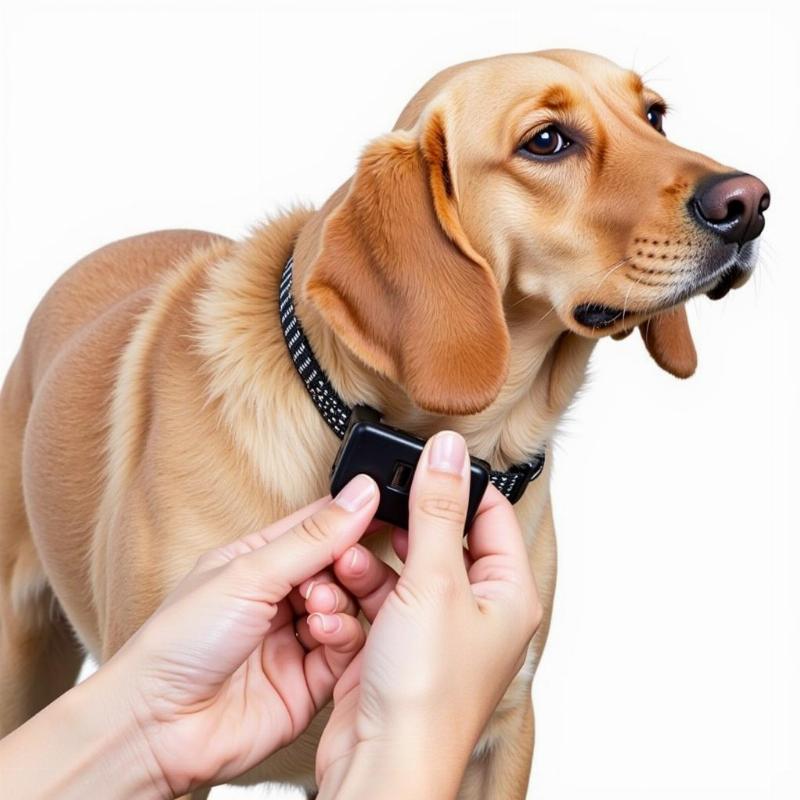A bark collar isn’t a magic fix, and figuring out why it’s not working on your dog can be frustrating. Many dog owners in the US turn to bark collars as a solution for excessive barking, but sometimes they find the collar isn’t as effective as hoped. Let’s explore the common reasons why a bark collar might not be working on your furry friend and what you can do about it.
Why Isn’t My Dog’s Bark Collar Working?
Several factors can contribute to a bark collar’s ineffectiveness. Understanding these reasons is the first step to finding a solution that works for both you and your dog. Is the collar fitted correctly? Is the battery dead? Or perhaps your dog has simply learned to outsmart the device. Let’s delve deeper into these possibilities.
Collar Fit and Positioning
A poorly fitted collar can significantly impact its effectiveness. Too loose, and it might not register the bark vibrations. Too tight, and it could be uncomfortable and even harmful. Ensure the collar fits snugly, allowing for two fingers to fit comfortably beneath it. The contact points should be positioned against your dog’s throat for optimal performance.
 Bark Collar Fit on a Dog
Bark Collar Fit on a Dog
Battery Issues
A dead or weak battery is a common culprit. Always check the battery first if your bark collar seems ineffective. Replace the battery with a new one, ensuring it’s the correct type and properly installed. For rechargeable collars, make sure they are fully charged before use.
Collar Type and Sensitivity
Different bark collars utilize different correction methods, such as vibration, static stimulation, or ultrasonic sound. Some dogs respond better to certain types than others. The sensitivity setting also plays a crucial role. If set too low, the collar might not activate. If set too high, it could be triggered by other noises or even your dog’s movement. Experiment with different settings to find what works best for your dog’s breed and temperament.
Dog’s Temperament and Training
Some dogs are more stubborn or persistent barkers than others. They might learn to bark in a way that avoids triggering the collar or simply tolerate the correction. In such cases, combining the bark collar with consistent training is essential. Positive reinforcement methods, like rewarding quiet behavior, can be highly effective.
Underlying Medical Conditions
Excessive barking can sometimes be a sign of an underlying medical condition, such as anxiety, pain, or cognitive decline. If your dog’s barking seems unusual or accompanied by other symptoms, consult a veterinarian to rule out any medical issues. A bark collar is not a substitute for addressing potential health problems.
Troubleshooting Your Bark Collar
If your bark collar isn’t working, try these troubleshooting steps:
- Check the Battery: Replace or recharge the battery.
- Adjust the Fit: Ensure the collar is properly fitted and the contact points are positioned correctly.
- Adjust the Sensitivity: Experiment with different sensitivity levels.
- Combine with Training: Use positive reinforcement techniques to reward quiet behavior.
- Consult a Veterinarian: Rule out any underlying medical conditions.
- Consider Professional Help: A certified dog trainer or behaviorist can provide personalized guidance.
Expert Insights
Dr. Emily Carter, a certified veterinary behaviorist, notes, “Bark collars should be used responsibly and as a part of a comprehensive training plan. They are not a quick fix and should never be used on puppies or dogs with anxiety or aggression issues.”
John Davis, a professional dog trainer with over 15 years of experience adds, “Pairing a bark collar with positive reinforcement training is crucial for long-term success. Rewarding your dog for quiet behavior is often more effective than simply correcting unwanted barking.”
Conclusion
Addressing a malfunctioning bark collar requires patience and a systematic approach. By checking the fit, battery, sensitivity, and considering your dog’s temperament and potential underlying medical conditions, you can increase the chances of finding a solution that works. Remember, combining the bark collar with positive reinforcement training is key to achieving long-term results and fostering a harmonious relationship with your furry companion. Don’t hesitate to seek professional help from a veterinarian or certified dog trainer if needed.
FAQ
- Q: My dog’s bark collar is beeping but not correcting. What should I do? A: This could indicate a low battery. Try replacing or recharging the battery.
- Q: Can I use a bark collar on a puppy? A: It’s generally not recommended to use bark collars on puppies younger than six months.
- Q: Is it safe to leave a bark collar on my dog all the time? A: No, it’s important to remove the collar periodically to prevent skin irritation.
- Q: My dog seems distressed by the bark collar. What should I do? A: Stop using the collar immediately and consult a veterinarian or certified dog trainer.
- Q: Are there any alternatives to bark collars? A: Yes, positive reinforcement training, desensitization, and counter-conditioning are effective alternatives.
- Q: What type of bark collar is best for my dog? A: The best type of bark collar depends on your dog’s breed, temperament, and barking habits. Consult with a professional for personalized recommendations.
- Q: Can a bark collar cause harm to my dog? A: While generally safe when used correctly, improper use can cause discomfort or skin irritation. Always follow the manufacturer’s instructions.
Related Articles
- will a shock collar stop a dog from biting
- electric shock collar for small dogs
- no shock dog training collar
- dog bark collars for small dogs
Beautdogs.us is your premier online resource for all things dog-related in the US. We offer expert advice on dog breeds, care, training, and product reviews to help you provide the best possible care for your canine companion. Whether you’re a new dog owner or a seasoned pro, Beautdogs.us is your trusted source for comprehensive and engaging information. Contact us today for personalized support at [email protected] or call us at +1 501-555-7529.